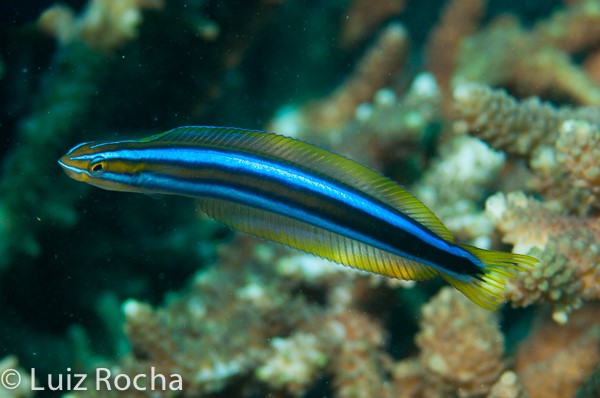This is our second guest post from ichthyologist, tech diver and all-round good guy Dr. Luiz Rocha at the California Academy of Sciences. You should follow him on Twitter
When you hear “vampires” you usually think “Twilight”, “Vampire Diaries” or “True Blood”. However, a very interesting group of fishes have also taken up the name. Vampire Blennies (a.k.a. Fang Blennies or Sabertooth Blennies) have elongated fangs that give them great versatility. Blennies are a diverse family small fishes that are poor swimmers usually with secretive behavior. Most hide in crevices in the reef or swim always in contact with the bottom to avoid being eaten. But unlike other Blennies (and human vampires), Vampire Blennies are often out in the open because larger predatory fish are scared of their fangs and painful bites!

Many Vampire Blennies use their large fangs and powerful jaws to snack on other fishes. The Bluestriped Fangblenny darts towards much larger fish and removes scales, chunks of skin and/or pieces of fin to feed on. But fish learn to recognize them and stay away as much as possible.

And that’s why the False Cleanerfish adopted an incredible strategy. It looks exactly like the Cleaner Wrasse, a fish that removes parasites from the skin of other fishes. By looking like the Cleaner Wrasse, the False Cleanerfish easily gets close to other fish, but instead of cleaning, it bites!

Unlike the species discussed so far, perhaps the most incredible group of Vampire Blennies, the genus Meiacanthus, uses their fangs for defense, not attack. They have a very specialized venom gland enveloping the base of their canines. When attacked by larger fish, they use their long sharp fangs to inject venom into their attacker. During my last trip to the Red Sea, when attempting to carefully take a small tissue sample of a live Black-Lined Vampire Blenny and return it to the reef, it bit me! Even though there are scattered reports of painful bites, my bite wasn’t painful at all. I was just shocked to see that a small fish like that (about 2 inches long) could cut my skin in one bite with such ease: the fangs were extremely sharp and strong.

The Meiacanthus defense mechanism is so effective at deterring predators that most are mimicked by other blennies, cardinalfish or even juvenile breams. Predators tend to avoid Meiacanthus due to previous bad experiences, so by looking like them, the mimics get protection. Moral of the story? In the coral reef, looking like a vampire is a good thing and will keep predators away!






